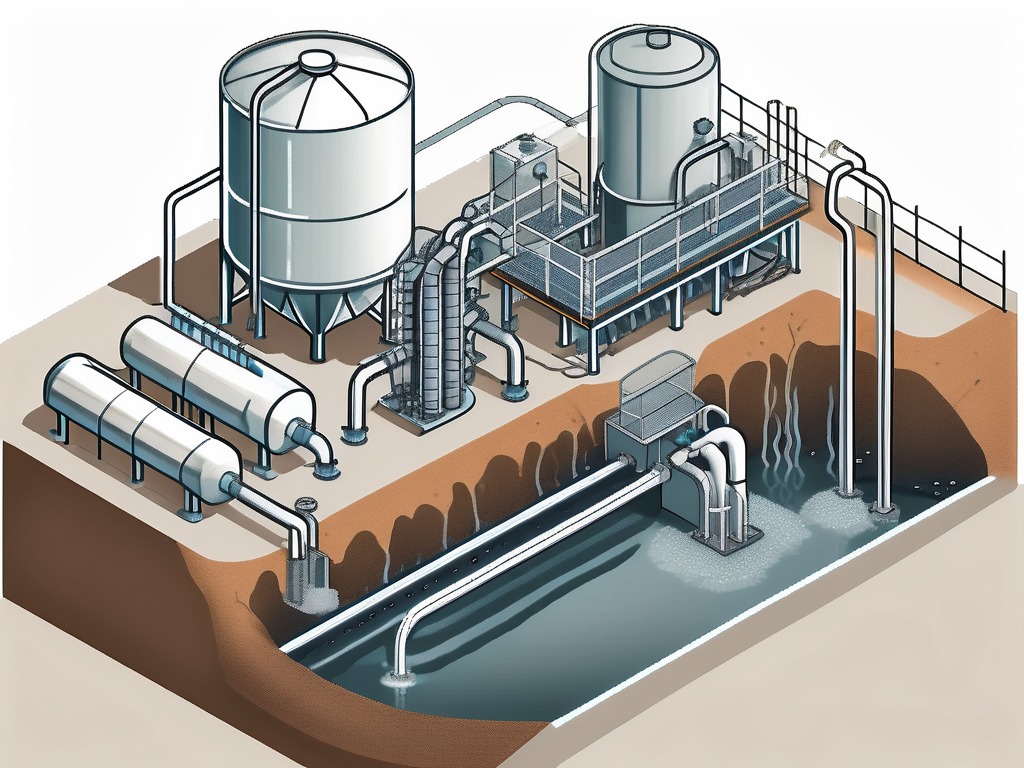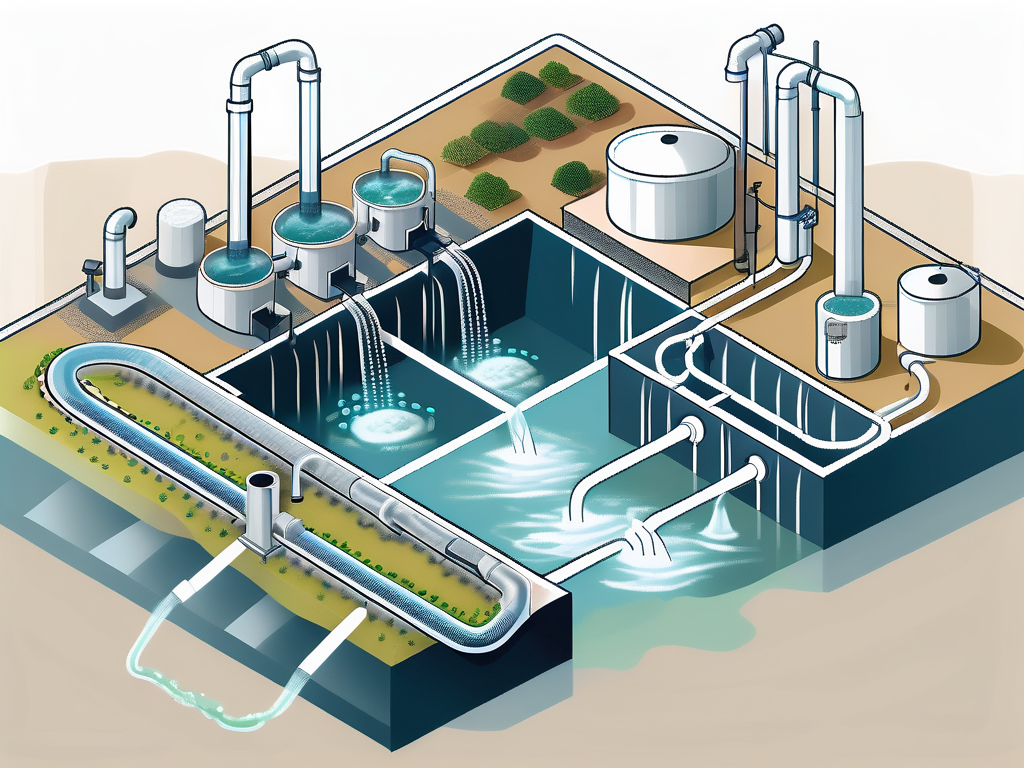
Recycled Water: Wastewater Treatment Explained
Wastewater treatment is a critical process that ensures the health and safety of our communities and the preservation of our environment. It involves the removal of contaminants from wastewater, primarily from household sewage, to produce an effluent that can be returned to the water cycle with minimal environmental impact. This article delves into the intricacies of wastewater treatment, explaining the various stages involved and the technologies used.
Understanding wastewater treatment is essential for appreciating the value of recycled water, which is a product of this process. Recycled water, also known as reclaimed water, is wastewater that has been treated to a high standard, making it safe for a variety of uses. This glossary article will provide a comprehensive understanding of the wastewater treatment process and the importance of recycled water.
Wastewater Sources
Wastewater originates from various sources, each contributing different types and levels of pollutants. The primary sources include residential, industrial, commercial, and agricultural activities. Understanding these sources is critical in designing and operating effective wastewater treatment systems.
Residential wastewater, also known as sewage, is generated from activities such as bathing, laundry, and toilet flushing. It contains a mixture of organic materials, nutrients, pathogens, and microorganisms. Industrial wastewater, on the other hand, can contain a wide range of pollutants depending on the nature of the industry. These can include heavy metals, organic compounds, and other harmful substances.
Commercial and Agricultural Wastewater
Commercial wastewater is similar to residential wastewater but may also contain pollutants specific to the commercial activity. For example, wastewater from restaurants and food processing facilities often has high levels of fats, oils, and grease. Agricultural wastewater, generated from activities like irrigation and livestock rearing, typically contains high levels of nutrients and organic matter, as well as pesticides and other agrochemicals.
Each type of wastewater requires a different treatment approach to effectively remove its specific pollutants. Therefore, understanding the source of wastewater is a crucial first step in the treatment process.
Wastewater Treatment Process
The wastewater treatment process involves several stages, each designed to remove a specific type of pollutant. The process can be broadly divided into preliminary, primary, secondary, and tertiary treatment stages. Each stage employs different technologies and methods to treat the wastewater.

The preliminary treatment stage involves the removal of large solids and grit that could damage the treatment plant's equipment. This is typically achieved using screens and grit chambers. The primary treatment stage involves the separation of suspended solids and organic matter from the wastewater, usually through sedimentation in primary clarifiers.
Secondary and Tertiary Treatment
The secondary treatment stage is where the majority of the organic matter in the wastewater is removed. This is achieved through biological processes, where microorganisms consume the organic matter as food, converting it into water, carbon dioxide, and energy for their growth. The tertiary treatment stage involves the removal of remaining suspended solids, nutrients like nitrogen and phosphorus, and pathogens. This is typically achieved through filtration, disinfection, and other advanced treatment processes.
Each stage of the wastewater treatment process plays a crucial role in producing recycled water that is safe for reuse. The level of treatment required depends on the intended use of the recycled water.
Recycled Water Uses
Recycled water has a wide range of uses, depending on the level of treatment it has undergone. Some of the common uses include irrigation, industrial processes, toilet flushing, and dust control. In some cases, recycled water can also be used to augment drinking water supplies, a practice known as potable reuse.
Irrigation is one of the most common uses of recycled water, particularly in arid regions where water resources are scarce. Recycled water is ideal for this purpose as it is typically rich in nutrients, which can benefit plant growth. For industrial processes, recycled water can be used for cooling, washing, and other processes that do not require potable water.
Potable Reuse
Potable reuse involves treating recycled water to a high standard so that it can be used as a drinking water source. This practice is becoming increasingly common in regions facing water scarcity. Potable reuse can be direct, where the recycled water is treated and then directly added to the drinking water supply, or indirect, where the recycled water is first introduced into an environmental buffer, such as a reservoir, before being treated further and added to the drinking water supply.
Regardless of the use, it is essential that recycled water is treated to a standard that is appropriate for its intended use, to protect public health and the environment.
Wastewater Treatment Technologies
There are numerous technologies available for treating wastewater, each suited to removing a specific type of pollutant. These technologies can be physical, chemical, or biological in nature. Physical treatment technologies include screening, sedimentation, and filtration, which remove solids from the wastewater. Chemical treatment technologies include coagulation, flocculation, and disinfection, which remove pollutants through chemical reactions.

Biological treatment technologies, which are the heart of the secondary treatment stage, use microorganisms to consume organic matter and nutrients in the wastewater. There are various types of biological treatment processes, including activated sludge, trickling filters, and lagoons, each with its own advantages and disadvantages.
Advanced Treatment Technologies
Advanced treatment technologies are used in the tertiary treatment stage to remove remaining pollutants and produce high-quality recycled water. These technologies include membrane filtration, reverse osmosis, advanced oxidation, and others. Membrane filtration and reverse osmosis are particularly effective at removing suspended solids, bacteria, viruses, and other microorganisms, as well as dissolved salts and organic compounds.
Advanced oxidation processes, which involve the generation of highly reactive oxygen species, are effective at removing a wide range of organic compounds, including those that are resistant to conventional treatment processes. These advanced treatment technologies play a crucial role in enabling the safe reuse of wastewater.
Regulations and Guidelines
Wastewater treatment and the use of recycled water are heavily regulated to protect public health and the environment. These regulations and guidelines specify the level of treatment required for different uses of recycled water, as well as monitoring and reporting requirements to ensure compliance.
In the United States, the Environmental Protection Agency (EPA) is the primary regulatory authority for wastewater treatment and recycled water use. The EPA's guidelines for water reuse provide a comprehensive framework for the safe and effective use of recycled water. Other countries have their own regulatory authorities and guidelines, which may differ in their specifics but generally aim to achieve the same goal of protecting public health and the environment.
Future Trends
As water scarcity becomes an increasing concern worldwide, the importance of wastewater treatment and the use of recycled water are expected to grow. Advances in treatment technologies, particularly in the area of advanced treatment, are enabling the production of higher quality recycled water, expanding its potential uses.
At the same time, there is a growing recognition of the value of the resources that can be recovered from wastewater, such as nutrients and energy. This is leading to a shift towards resource recovery facilities, which not only treat wastewater but also recover valuable resources from it. These trends are expected to shape the future of wastewater treatment and the use of recycled water.



